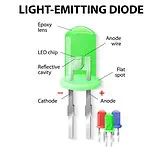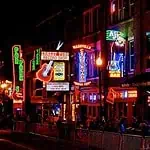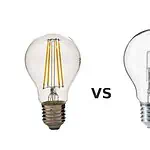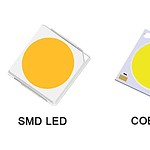When choosing lighting types, LEDs are the most popular and reliable option. Besides, within a brief period, it has replaced traditional lighting like- halogen or incandescent bulbs. But how? To find the reason for such popularity, you should know the advantages and disadvantages of LED lighting.
The advantages of LED lights are numerous. Among these, LEDs’ energy efficiency, easy maintenance, and durability are the most worth mentioning. Besides, they don’t contain harmful gasses or toxic chemicals, which makes them eco-friendly. Yet, these broad advantages are followed by a few drawbacks, i.e., blue LEDs cause pollution and harm eyesight. But still, LED lights are far better options when compared to other conventional lights.
In this article, I’ve discussed the benefits and drawbacks of LED lights in detail. Besides, I also suggested LED lighting options that will suit your project the best. So without any further delay, let’s jump into the details-
What is LED Lighting?
LED stands for Light-Emitting diodes. A new lighting technology generates visible lighting by passing electricity to semiconductors. Besides, LED lights are energy-efficient and more durable compared to traditional lighting. That is why they have replaced conventional lighting like- incandescent or fluorescent lamps.
How Do LEDs work?
When electricity passes through traditional lighting, like fluorescent bulbs, it heats the filaments to generate visible lighting. But LED lights don’t have such a working mechanism. Instead of heating up, they follow the principle of electroluminescence to illuminate.
The semiconductor of LED is composed of two layers- n-type and p-type. The n-type layer contains a surplus of electrons, whereas the p-type creates holes due to electro deficiency.
In this stage, as electricity passes through the diodes, the electron from the n-type jumps toward the holes of the p-type layer using the p-n junction. And this flow of electrons from high electron-concentrated regions to low electron-concentrated areas generates visible light spectrums.
Thus, LED illuminates through the process of electron flow.
Advantages of LED Lighting
At present, LEDs are the most used lighting application worldwide. The popularity of LED lights is due to the benefits they provide that traditional lights lack. These advantages of LED lights are as follows-
Energy Efficient
LED lights consume much less energy than traditional lights. They bring the same intensity of illumination using 5-8 times less energy than incandescent bulbs. Generally, an incandescent bulb’s energy is converted to heat rather than light. As a result, significant energy is wasted as system loss. But in LED light, most energy transforms into light with minimal loss. Thus, they are energy-efficient and money-saving.
Optical Delivery Efficiency
The traditional Bulbs emit light in all directions. Due to this, a large portion of the output light is trapped inside reflectors and diffusers. Besides, some light rays escape in unintended directions, causing glaring. In contrast, using compound lenses, LEDs’ compact form factor and directional nature allow effective light delivery. Thus, the optical efficiency of well-designed LED lighting systems can reach over 90%.
Cost-Effective
The LED lights use less energy and save electricity bills. Moreover, they don’t break out easily like glass bulbs. So, no maintenance or frequent changing is required with LEDs. And this is what makes them cost-effective and durable.
Instantaneous Action
LED lights can switch on 140 – 220 milliseconds faster than incandescent bulbs. As a result, LED bulbs glow almost instantly. On the other hand, compact fluorescent lamps can take up to 3 minutes to reach their full brightness. In addition, frequent switching doesn’t affect the lifespan of LEDs as it shortens the life of incandescent, fluorescent, and HID lamps.
Illumination Uniformity
Non-uniform illumination creates uneven lighting that causes visual fatigue and affects task performance. And to solve these problems, LEDs are great lighting options. They create uniform illumination that contributes to high visual comfort and permits flexibility in task performance.
Spectral Engineering
LED technology offers spectral engineering to engage specific human visual, physiological, or psychological needs. Thus, you can have greater control over the spectral distribution for different lighting. For instance- RGB or RGBW LED strips come with thousands of color mixing options to create aesthetic lighting. Again, tunable white LED strips allow you to control light spectrums by adjusting the color temperature and intensity of the lights.
Dimming Capability
Regular fluorescent lamps are not compatible with dimming control and are expensive too. Meanwhile, LED lights are excellent for dimming capability. Moreover, LED dimming comes with two options: analog dimming (CCR) and digital dimming (PWM).
Analog Dimming Of LED
Analog dimming of LEDs is the most used dimming solution for general lighting. It works through constant current reduction (CCR), controlling the drive’s current flow. But the drawback is that analog dimming LEDs don’t perform well for current flows below 10%.
Digital Dimming Of LED
Digital dimming of LED works by applying pulse width modulation (PWM) technology. Such a dimming system reduces the power loss of LEDs while dimming them. For instance, LEDs with a PWM dimming system can produce 3000:1 or higher dimming ratios (at 100Hz) without any significant loss of accuracy.
Design Flexibility
LEDs have a wide range of design flexibility. Its small and compact design allows you to use it for various functions. In addition, they offer different lighting design options with versatile categories, i.e., LED bulbs, tube lights, flexible LED strips, or neon lights. And this is why LED lights are the best choice for any lighting solution.
Product Life.
The LED’s lifespan is much higher compared to regular incandescent bulbs. Where the average lifespan of incandescent bulbs is thousands of years, LED lights have an average lifespan of 35,000 and 80,000 hours. Plus, it can last 20-25 times longer than a typical halogen and 8-10 times longer than a typical CFL.
Less Bulk
The small structure of the LED lights is one of the plus points, especially regarding LED strips. As a result, they are incredibly lightweight, easy to install, and versatile to use. Besides, LEDs maintain their illuminating performance for their tiny sizing. As a result, these compact lights can glow as bright as traditional fluorescent lights using lesser energy.
Offer Directional Light
Incandescent and CFL bulbs offer directional lights at 360 degrees. Meanwhile, LED lights are directional light sources focusing the lights on 180 degrees. That means it only emits light rays in a particular direction reducing light pollution and unnecessary glaring effects. Thus, LED uses energy and lights more efficiently than traditional fluorescent or incandescent bulbs.
Easy Maintenance
LED lights don’t require frequent replacement; as a result, there is no need to keep up with regular maintenance. Thus, it saves your effort, money, and time. Plus, these lights are great for use in remote areas as no maintenance is required.
More Robust
Instead of a glass bulb or tube, like traditional incandescent and halogen lamps, an LED emits light from a block of semiconductors. So, there is no risk of broken glass with LEDs. In addition, LED lights have more extended durability and are incredibly resistant to shock, vibration, and wear.
Attract Fewer Bugs and Insects
Light sources easily attract bugs and insects. Especially in the case of incandescent lighting, the attraction of bugs is more. That is why they are inconvenient to use outdoors. Meanwhile, LED lights are proven to attract fewer bugs and insects. So you can easily use them outdoors.
More information, you can read Do LED Strip Lights Attract Bugs?
Convenient To Use
LED lights usually don’t blow out abruptly as incandescent bulbs. Instead, it tends to dim over a long period. So, it doesn’t require frequent fixture changing as other traditional lighting options.
Environmentally Friendly
Unlike conventional fluorescent bulbs, LED lights don’t contain other hazardous substances like- mercury. Additionally, LEDs are highly energy efficient. And this makes them a perfect addition to renewable energy sources like solar power. Thus, LEDs are environmentally friendly in comparison to other lighting options.
Lighting Control
LEDs allow you greater control over lights. For example, you can adjust the brightness of the LEDs to your liking. Besides, you can also control the lighting colors and patterns with smart LEDs like LED strips. In contrast, traditional lighting doesn’t offer you such facilities.
Photobiological Safety
Light sources that produce infrared or UV rays cause photobiological hazards. However, LED lights have no infrared (IR) rays which are hazardous to the skin or eyes. On the other hand, fluorescent and incandescent bulbs convert 37% and 73% of the total power consumption into infrared energy, respectively. Besides, the UV ray emission of LED lights is less than 5 uW/lm. In comparison, the UV ray emission by the incandescent lamp and compact fluorescent are 70-80 uW/lm and 30-100 uW/lm. Thus with LEDs, light sources are photo biologically safe and environment friendly.
Radiation Effect
The light source produces radiant energy over the visible range of the light spectrum (IR or UV), causing photobiological hazards. And these rays are responsible for the discoloration of paintings, drying out vegetables and fruits, melting chocolate, etc. But with LEDs, you need not worry about these problems. It only produces radiant energy within the visible wavelength of electromagnetic spectrums (400 nm to 700 nm). And so are suitable for using a museum or confectionery without worrying about product damage.
Fire and Explosion Safety
In traditional light bulbs, the tungsten filament is heated up, or gasses inside the bulb are excited to illuminate the light source. And so, this type of lighting involves a severe risk of exploration and fire breakout. In comparison, LEDs convert electrical energy into electromagnetic radiation inside a semiconductor package. Therefore, unlike traditional bulbs, they don’t heat up and are a safer option than conventional light bulbs.
Visible Light Communication (VCL)
Every LED light can be used as an optical access point for wireless data communication (if the LED driver can transform streaming content into digital signals). And utilizing this feature of LEDs, there appeared a new technology, Li-Fi (Light Fidelity). It is a wireless communication system that leverages LEDs’ “ON” and “OFF” sequences to transmit data. Moreover, with Li-Fi, you can get a thousand times wider bandwidth and higher transmission speed than Wi-Fi or Bluetooth.
DC Lighting
LED lights are low-voltage devices that use direct current (DC) distribution grids. This DC lighting feature of LED increases the stability of the installation and reduces the likelihood of lighting failures. In addition, they are more dependable circuits and require less maintenance. And direct lighting-based LEDs are as much as 75% more efficient than incandescent lighting.
No Heat Emission
Traditional incandescent bulbs emit tremendous heat, making them too hot while operating. They turn more than 90% of the electrical energy in an incandescent bulb into heat energy and convert only 10% to light energy. On the other hand, LEDs emit almost no heat during operation. So, they are more efficient and ideal for illuminating artworks that will break down over time with exposure to UV rays.
Cold Temperature Operation
Cold temperature is the biggest challenge for fluorescent bulbs, requiring high voltage to start at cold temperatures. But the start-up of LED lights is independent of temperature. Therefore, they work perfectly at temperatures below -50 degrees Celsius. For this reason, they are ideal for lighting refrigerators, freezers, cold storage, and outdoors.
Customizability
You can customize and play with light colors with LED lights, i.e., LED strips. For instance, an RGB LED strip with an intelligent controller offers you a variety of color combinations with DIY color options. So, you can mix the primary red, green, and blue colors to prepare the desired light color on your own.
Compatible with Smart Home Applications
One of the most outstanding features of LED lights is that they are compatible with smartphones. You can connect them to your phone through Wi-Fi or Bluetooth and operate them efficiently. Such facilities are far beyond imagination in using traditional light bulbs.
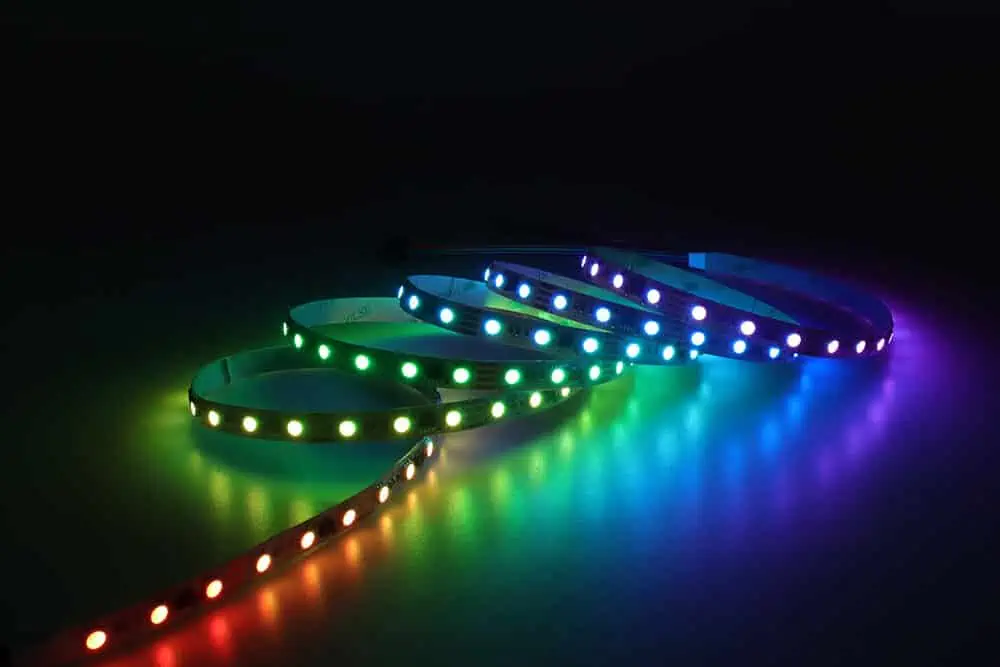
Disadvantages of LED Lights
Besides numerous advantages, LED lights also have a few disadvantages you should consider before choosing any LED lighting. These are as follows-
Increase the Blue Hazard
The blue light produced by blue and cool white LEDs causes more glare and impairs vision. Studies further show that blue lights affect muscular degeneration and also cause damage to photoreceptor cells. Thus, blue LEDs are harmful to the human eye.
Cause Blue Pollution
The rate of blue light pollution in cool white LEDs is much higher than in other traditional lighting sources. These blue light rays affect the natural circadian rhythms and thus hamper the regular sleeping cycles. Yet, to avoid such situations, you are recommended to avoid using white LEDs with a correlated color temperature above 3,000K. For this, warm-tone LED lighting options like dim to warm LED strips are great choices.
Extremely Voltage-Sensitive
LEDs are sensitive to inappropriate voltage inputs. And getting the voltage slightly wrong in an LED-based system is a bigger problem for the LED. So, it is essential to calculate the voltage drop carefully and correctly to avoid any adverse effect on the lifespan of LEDs.
Do Not Allow Spherical Light Distribution
Fluorescent lamps and incandescent sources allow more excellent diverging capability with spherical light distribution. But LEDs’ directional lighting nature does not allow spherical light distributions. As a result, the diverging light ability of LEDs is also limited.
Expensive
In terms of pricing, halogen is the cheapest category of lighting. But LED lights have advanced technology that makes them more efficient and costly. For instance, you can purchase a halogen bulb for just $3, whereas a regular LED light can cost $10 or more. Yet, as LED lights require low maintenance and less frequent replacement, they are considered more cost-effective.
Incompatibility With Traditional Lighting Controllers
The controllers, i.e., dimmers already installed in homes, are usually designed for incandescent lights. However, an LED light uses a different dimming method that doesn’t work with traditional controllers. So, you need to include an additional cost to your LED installation process to get a compatible LED controller.
Types Of LED Bulbs
LED lighting can be classified into two categories based on its formation structures. These are-
- Standard LED Bulbs
In standard LED bulbs, chip remains are lined up in an aluminum circuit board. However, unlike traditional bulbs like halogen or incandescent bulbs, they are not made of glass. Instead, LED bulbs are enclosed by plastic which makes them more robust.
- Filament LED Bulbs
Microscopic LED chips are combined to form filament wires in filament LED bulbs. And these filaments are coated in a yellow phosphorus coating that gives a warm lighting effect. Besides, these LEDs are enclosed by a glass outlet to provide a traditional bulb outlook. However, filament LEDs are more expensive and mainly used in chandeliers for their classic appearance.
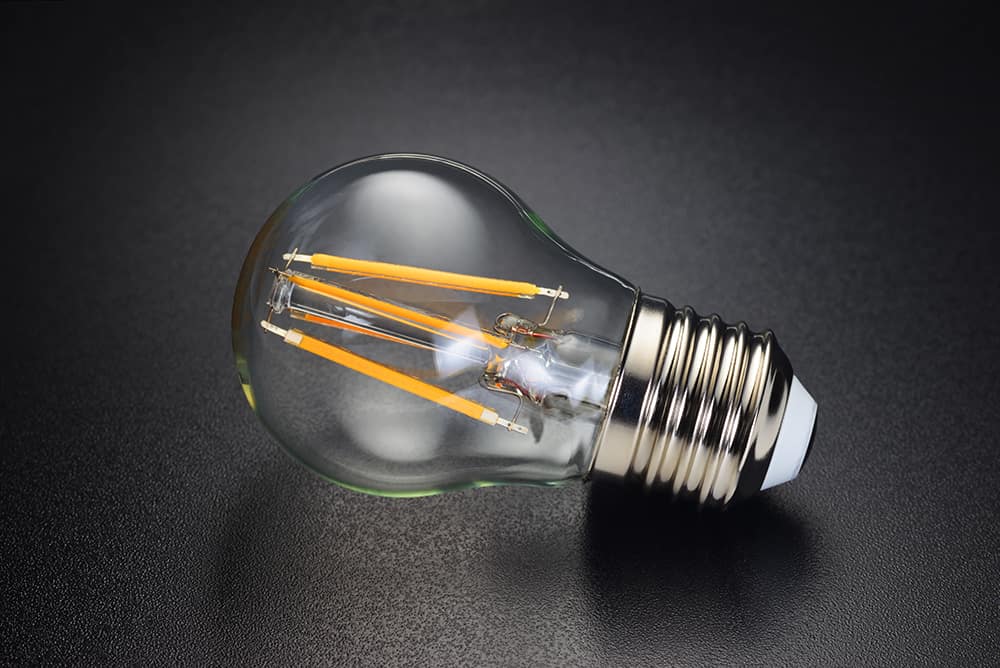
Different LED Lighting Technologies
LED lights have a wide range of variations in lighting types and technologies. And these lighting technologies are of the following four types-
- Dual In-Line Package (DIP) LEDs:
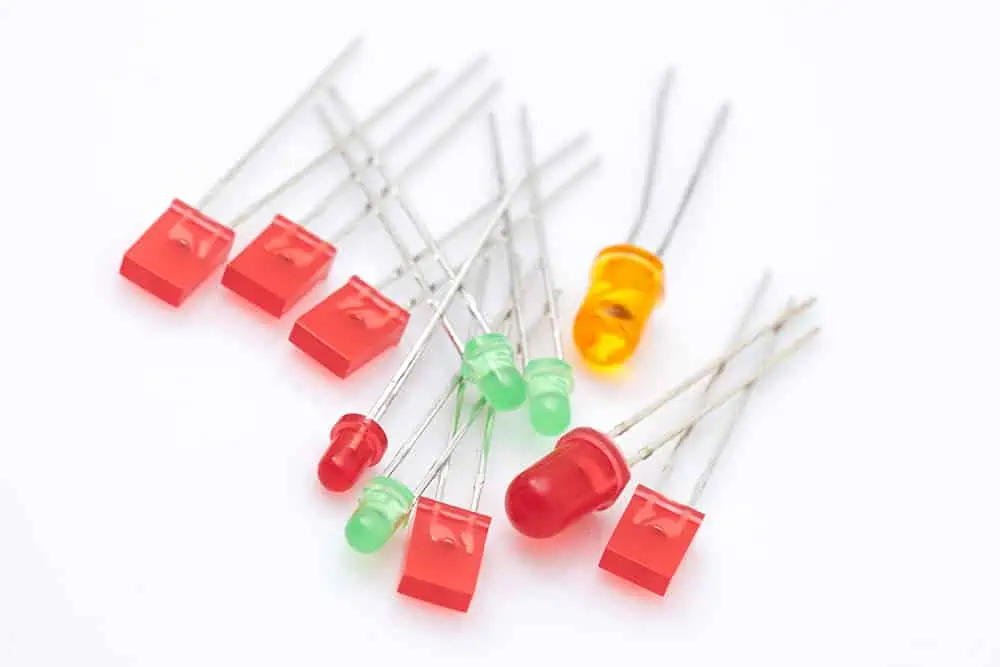
DIP (Dual In-Line Package) LEDs are the traditional form of LED lights. They have a plastic-coated chip structure with two straight and parallel connecting pins. And compared to modern LEDs, DIP LEDs have less efficiency and can only emit a limited amount of brightness (around 4 lumens/LED).
| Advantages | Disadvantages |
| long feet of DIP enable the led bulbs to perform better on heat dissipationSupports long lifetime for LED displaysCan deliver ‘focused’ screenConsumes less energy | Can’t go smaller than 10mm pixel pitchSmaller viewing angle Higher production and manufacturing cost |
- Surface Mounted Diode (SMD) LEDs:
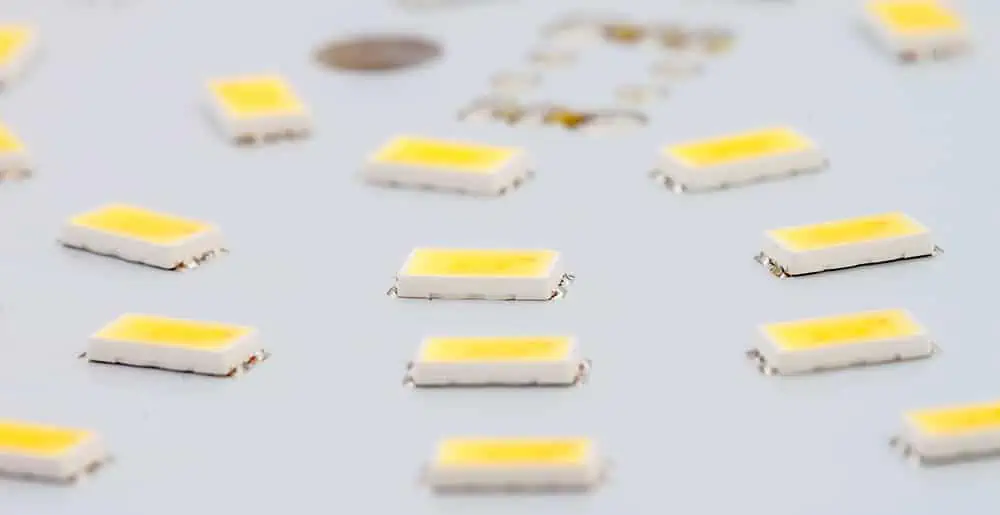
SMD LEDs are surface-mounted diodes placed directly onto the surface of printed circuit boards (PCBs). Compared to DIP LEDs, SMD LEDs are more efficient and brighter, making them a better lighting option. In addition, where a DIP LED uses three independent bulbs for RGB, SMD can put three diodes in the same chip. Thus, SMD LEDs are more compact and offer versatile lighting options.
| Advantages | Disadvantages |
| Small in size ( 2mm indoors and 5mm outdoors)Higher lighting resolutionBetter viewing angles Better color accuracy and slightly improved reliabilitySupports versatile light-controlling options | It uses more energy in comparison to DIP LEDsHarder to Service May create dots; (can be avoided using high-density SMD LEDs) |
- Chip on Board (COB) LEDs:
COB (Chip on board) LED is a high-powered LED lighting technology where chips are directly encapsulated on a substrate ( PCB or silicon) to produce LED arrays. As a result, they can have brighter illumination compared to DIP and SMD. Moreover, COB LEDs are energy efficient and carry multiple diodes (9 or more) in a single chip.
| Advantages | Disadvantages |
| Condensed dimension supports spotless lighting High efficiency; (produces greater brightness using less energy) Great uniformityStrong intensityLess heat emission Supports large focusing areas | Lower repairabilityLimited color selectionMore expensive than SMD chips |
- Chip Scale Package (CSP) LEDs:
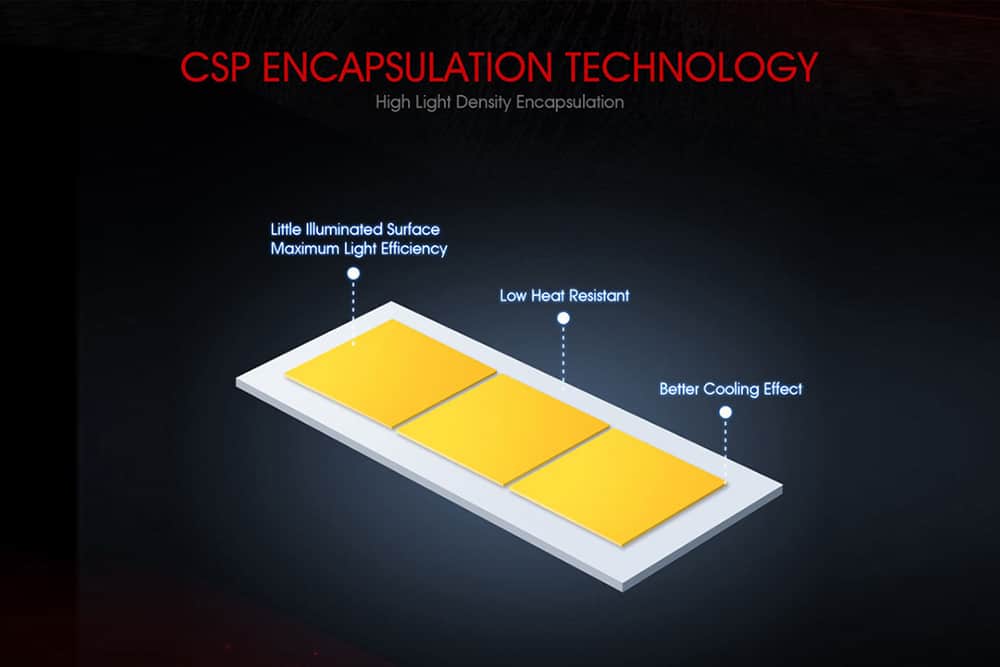
Chip scale package LEDs or CSP is the latest LED technology that emits the highest illumination at the smallest size available in the market. These LED packages are equivalent to the size of LED chips or at most 20%. One of the main benefits of such LEDs is that they do not require a soldered wire connection. That is how they reduce thermal resistance and possible light failure points.
| Advantages | Disadvantages |
| Better heat dissipationHigher lumen densityNo holder and alloy wiring requirements Fewer production processesMore flexible & reliable | Poor light transmittanceHigh priceGhosting phenomenon of backlight penetration. |
Why Choose LED Strips For Lighting?
LED strips are the most flexible and versatile lighting category of LED lighting. They are ideal for both indoor and outdoor uses. Besides, LED strips offer you a wide range of light-controlling facilities that opens numerous reasons to choose them for lighting. Yet, I have highlighted a few strong reasons why you should go for LED strips instead of other LED lighting-
Flexibility
LED strips are super flexible and have a rope-like structure that supports bending for easy installation. As a result, these strips are very lightweight and convenient to use. Besides, they also offer you resizing/cutting facilities. Thus, you can use these flexible LED strips anywhere with ease.
Versatility
When it comes to versatile lighting, nothing can beat LED strips. Indoor lighting or outdoor, they are suitable for ant lighting tasks. Besides, they have advanced technology that offers intensity adjustment, dimming, color temperature control, and many other options. And so you can use them in the bedroom, kitchen, bathroom, facade lighting, office lighting, etc. Apart from all these, you can also make signage with these flexible strips and use it for commercial purposes or indoor decor.
Light Control Options
LED strips like –RGBX, Tunable White, dim to warm, or addressable LED strips offer you adequate control over light color and intensity. For instance, with RGB LED strips, you can get 16.7 million hues mixing the primary red, green, and blue! Again, tunable white LED strips color temperature adjusting facilities. You can control the light’s temperature from 1800K to 6500K to bring warm to cool shades of white. Besides, there is another category of LED strips known as dim-to-warm. These strips provide dimming facilities for warm white shades (3000K to 1800K) that give a relaxing and candle-like effect.
Yet, addressable LEDs stand out regarding color-controlling options. With these LED strips, you can control the color of every strip segment. Thus, you can have multi-coloring that gives a rainbow-like effect.
Customizable
LED strips offer various customization facilities unavailable on other LED lighting types. For instance, LEDYi has customizable options where you can choose the strip’s length, width, dimension, IP ratings, voltage, or even power consumption requirements for your LED strips. Besides, we also offer you the facility to include your labels and company information in our LED strips. So, LED strips by LEDYi are the best lighting solutions for personal, commercial, or business purposes.
Easy Install
LED strips are very easy to install and require lower maintenance. You don’t need any professional assistance installing LED strips. As they are flexible and resizable, you can install them on your own using connectors and LED drivers. Besides, these accessible installation features of LED strips offer you personalizing options where you can customize LED lighting using these flexible strips.
Check out How to Cut, Connect, and Power LED Strip Lights for a complete guide to LED strip installation.
Waterproof
Water-resistant features are crucial for any lighting type, especially outdoors. But no worries, LEDYi offers you the best waterproof lighting solution with IP67 and IP68-rated LED strips. So you can use them in the bathroom, poolside, or outdoor lighting. Yet, to choose the ideal waterproof LED strips, you must know about IP ratings. In this case- IP Rating: The Definitive Guide will help you to pick the best LED strips for your lighting project.
Color Accuracy
Light color accuracy is measured with Color Rendering Index (CRI). The higher the CRI rating, the better color quality a light can provide. For instance, single LED strips by LEDYi offers high CRI, Ra>90 / Ra>95, that gives accurate color as the natural lighting. Thus, the high CRI ratings of LED strips make them suitable for domestic and commercial purposes. For example, you can use them in shopping malls or outlets to showcase your product without worrying about color degradation.
Cost Effective & Durable
LED strips are more durable and energy-effective than other traditional light forms. It uses the least energy to bring out the maximum brightness. Thus, it saves your electricity bills minimizing power usage. And, regarding durability, LED strips can last much longer than classic lighting. Besides, LEDYi offers a five years warranty on its LED strips, ensuring their quality and performance.
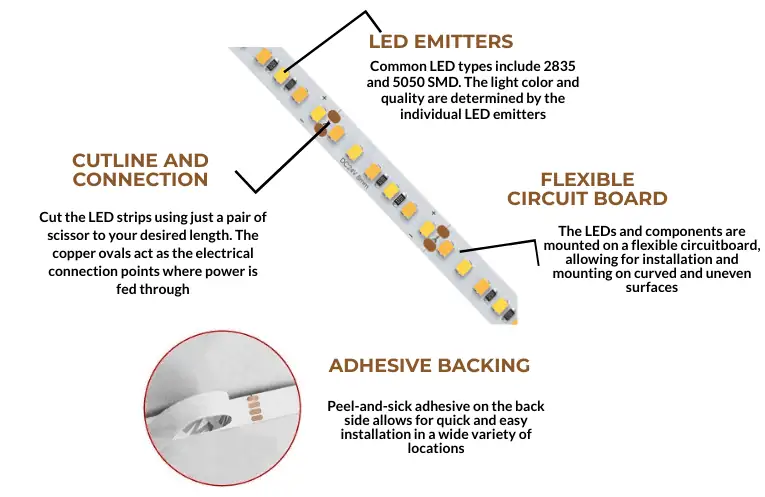
How To Choose LED Strips?
In choosing the ideal LED strips, you should consider some primary factors. These are as follows-
Length
Usually, the standard length of LED strip lights is 5 meters per reel. So, you must first calculate your length requirements and purchase reels accordingly. Yet, LEDYi offers customized options for strip lengths to meet your project requirements.
Dimension
The dimension of the LED chip is an essential factor to consider as it affects the lighting outlook. And the greater the dimension of the chip, the more prominent the lighting effect it creates. For instance, an SMD5630 LED strip with a chip dimension of 5.6mm * 3.0mm glows brighter than SMD2216 with a chip dimension of 2.2mm * 1.6mm.
Color
LED strips have a wide range of coloring options like- single color, RGB, RGBW, tunable white, dim-to-warm, addressable LED strips, etc. All of these lighting options offer you versatile light coloring options.
Tunable White LED Strips:
Tunable white LED strips offer you to change the color temperature of white lights to create warm to cool shades. These strips are connected to a tunable white controller with which you can adjust the color temperature from 1800K to 6500 K. So if you are looking for adjustable white lighting, tunable white LED strips are your best option.
Dim-To-Warm LED Strips:
Dim-to-warm LED strips are great for warm and cozy lighting effects (3000K to 1800K). With these strips, you can create candle-like natural effects for your indoor lighting. Besides, dim-to-warm LED strips are the best option for bedroom lighting as warm lighting creates a relaxing vibe and improves sleeping cycles.
Single-Color LED Strips:
Single-color LED strips are the most basic category of LED strips. They are available in different colors like- red, green, blue, yellow, pink, etc. You can choose any of these colors that suits you best. Besides, these LED strips are available in different power consumption and IP ratings, making them suitable for versatile uses.
RGBX LED Strips:
RGBX LED strips offer millions of color variations, mixing the primary colors- red, green, blue, and white. The most popular category of RGBX LED strips includes RGB, RGBW, and RGBWW. They are suitable for both indoors and outdoors and so widely used in the house, automobile, marine, commercial lighting, etc. Yet, before purchasing RGBX LED strips, check out “RGB vs. RGBW vs. RGBIC vs. RGBWW vs. RGBCCT LED Strip Lights” to find the best RGB variants for your lighting project.
Addressable LED Strips:
Addressable LED strips are the most versatile LED lighting options. They allow you to control the lighting in segments. That is, you can get multiple colors at a time running through the strips. In addition, they are visually attractive and come with many advanced technologies for which they are also known as dream color or magic LED strips.
LED Density
The density of LEDs indicates the number of LED chips per meter. The higher the density, the more even lighting it produces. Besides, LEDs with lower density create dots. So, it is always better to go with higher-density LEDs. Yet, LEDYi offers you LED density from 30LEDs/m to 720LEDs/m. And for dotless lighting, you can also go for our COB LED strips.
CRI Rating
CRI rating indicates the color accuracy of lighting. That is, with higher CRI grades, you get better color perceptions. So, always go for a LED strip with a higher color rendering index, CRI> 90 or above.
IP Rating
Ingress progress or IP rating denotes a fixture’s protection level against liquid and solid ingress. The IP rating allows us to find whether an LED strip is ideal for any particular use. For example- LED strips with IP65 are dust-protected but are not waterproof. So, though you can use them in areas where they may face dust issues, they are not suitable for wet environments. For water-resistant options, you need to go with IP67 or IP68.
Power Consumption
LED strips are available in various power consumption options from 2.4w/m to 30w/m. Besides, LEDYi offers customized options to get the ideal power consumption rate for your lighting tasks.
Therefore, these are the things that you must keep in mind before choosing any LED strips for your lighting project. Yet, if you need to inquire, contact the LEDYi service team, and we will help you to get the most suitable strips for your task.
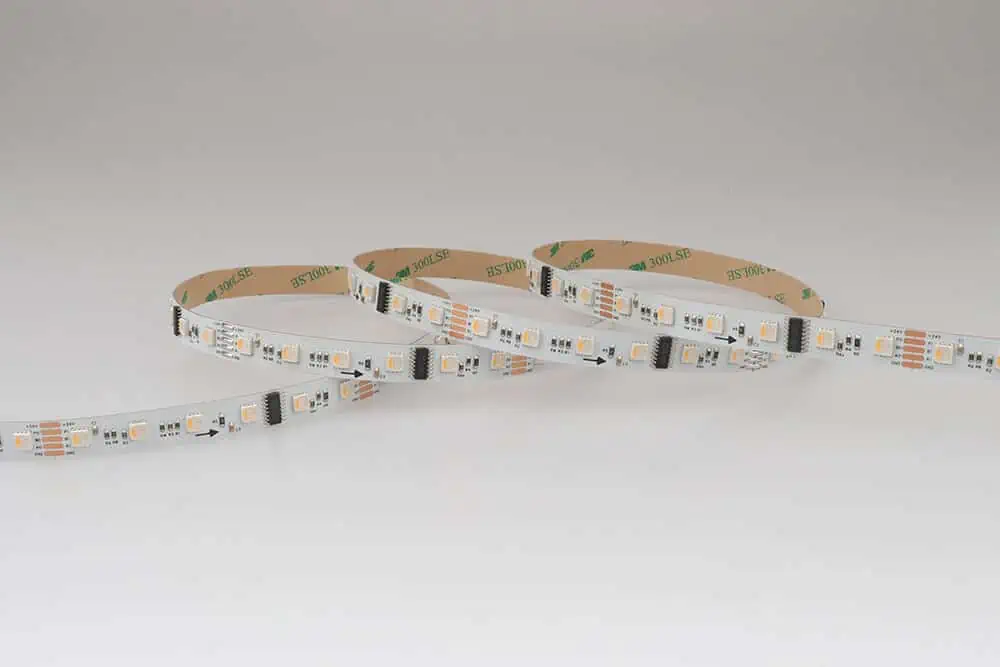
Are LED Lights Better Than Regular Lights?
Let’s compare LED lights and regular lights to find the better one between them-
- Regular lights like incandescent bulbs convert only 10% of the total energy to light; the rest, 90%, is wasted as heat energy. But, LEDs effectively use energy and convert most input energy to light. Thus, LED lights are 75% more energy efficient than regular lights.
- LED lights are more durable and can last up to 25 times longer than regular halogen bulbs.
- Regular bulbs contain mercury and produce UV and IR rays that harm the environment. Meanwhile, LED lighting doesn’t contain gasses or produce IR rays that can affect the environment or human health.
- LED lights are not temperature dependent. They can operate effectively in both cold and warm weather. But regular lights, like fluorescent bulbs, can function properly in cold weather.
- Regular lights are made of glasses that are temperature sensitive and can easily break. In contrast, LED lights are made of plastic and are more robust and durable.
Therefore, from the above discussion, undoubtedly, LED lights are a better option than regular lights.
Can You Use LED Strips For Outdoor Lighting?
Of course! LED strips are great for outdoor lighting. You can use them as signage, facade lighting, architectural lighting, outdoor event lighting, pool lighting, street lighting, etc. But for outdoor lighting, you must consider the dustproof and water-resistant capability of the strips. So, it would be best to look for LED strips with higher IP ratings, as outdoor lighting faces adverse weather conditions like- dust, rain, and storms.
FAQs
LED lights contain no hazardous materials like traditional lighting. Besides, they don’t emit UV or IR rays responsible for global warming. So, LEDs are not harmful to the environment.
LED lights are safe and free of toxic chemicals like mercury or harmful gases. Besides, LED lights have lower greenhouse gas emissions than conventional incandescent or fluorescent lights. That is why LED lights are eco-friendly.
LED lights are energy-effective and use minimal electricity without compromising the brightness. Thus, it can save 75% to 90% of electricity compared to traditional light sources.
Lumen indicates the total amount of lighting output; brightness. So, the bigger the lumen, the brighter light it produces. For example- SMD5630 LED strips with lumens of up to 50-60lm/LED have more brilliant illumination than SMD3528 with 9-10 lm/LED.
The full meaning of LED is Light-Emitting Diode. These LED chips contain one or more diodes that produce visible light spectrums through electron flow.
If LED gets too much current, it will try to dissipate as much power as applied. And at one stage, it will get overheated and destroy itself. That’s why limiting the current flow across the LED is important.
Blue LEDs damage retinal cells and cause vision problems. Thus, it can harm your eyesight. Yet, to avoid these problems, use warm white LEDs and avoid LED screens during bedtime.
Yes, RGB LEDs mix the primary colors (red, green, and blue) to form different color variants. Thus, they can also turn yellow by mixing red and green at equal proportions.
Conclusion
LED lights have many worth-mentioning advantages that I have already described above. They are energy-efficient, eco-friendly, and more durable. Besides, unlike traditional lighting, they can perform in adverse weather conditions. Apart from these, they also come with a few disadvantages, like- blue hazards and pollution caused by blue LEDs. But you can cut these issues by implementing the appropriate LED lighting options.
However, LED strips are the most convenient and versatile among the wide range of LED lighting options. You can use them for any illuminating task, from the bedroom to marine lighting. So, without any further delay, contact LEDYi soon to get the best LED strip for your lighting project!
